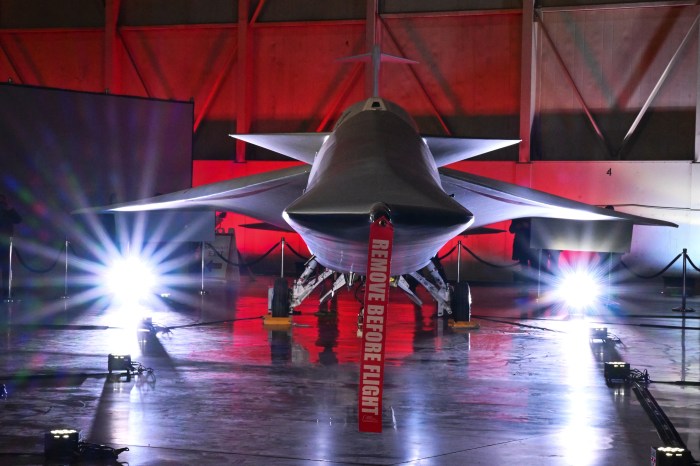_
NASA's and Lockheed Martin's X-59 experimental supersonic jet was unveiled during a ceremony in Palmdale, California, on Jan. 12, 2024.
The aircraft, a collaboration with Lockheed Martin Skunk Works, is the centerpiece of NASA's Quesst mission, with the goal of minimizing cross-country travel time by making supersonic flight over land possible.
The U.S. banned supersonic travel over land for non-military aircraft in 1973 due to public concern about sonic booms over populated areas.
NASA recently studied transoceanic supersonic flight, which could in theory shuttle passengers from New York City to London in under two hours.
Keep reading to see more of the best pictures of the new aircraft…
MORE: Follow Wonderwall on MSN for more fun celebrity & entertainment photo galleries and content
_
NASA and Lockheed Martin debuted the agency's new X-59 quiet supersonic aircraft during a media preview at Lockheed Martin Skunk Works in Palmdale, California, on Jan. 12, 2024. The supersonic jet is designed to fly at 1.4 times the speed of sound, or about 925 mph.
_
NASA and Lockheed Martin debuted the agency's new X-59 quiet supersonic aircraft during a media preview at Lockheed Martin Skunk Works in Palmdale, California, on Jan. 12, 2024. The supersonic jet is designed to fly at 1.4 times the speed of sound, or about 925 mph.
MORE: Follow Wonderwall on MSN for more fun celebrity & entertainment photo galleries and content
_
NASA's and Lockheed Martin's X-59 experimental supersonic jet was unveiled during a ceremony in Palmdale, California, on Jan. 12, 2024.
The aircraft, a collaboration with Lockheed Martin Skunk Works, is the centerpiece of NASA's Quesst mission, with the goal of minimizing cross-country travel time by making supersonic flight over land possible.
The U.S. banned supersonic travel over land for non-military aircraft in 1973 due to public concern about sonic booms over populated areas.
NASA recently studied transoceanic supersonic flight, which could in theory shuttle passengers from New York City to London in under two hours.
_
NASA and Lockheed Martin debuted the agency's new X-59 quiet supersonic aircraft during a media preview at Lockheed Martin Skunk Works in Palmdale, California, on Jan. 12, 2024. The supersonic jet is designed to fly at 1.4 times the speed of sound, or about 925 mph.
_
NASA and Lockheed Martin debuted the agency's new X-59 quiet supersonic aircraft during a media preview at Lockheed Martin Skunk Works in Palmdale, California, on Jan. 12, 2024. The supersonic jet is designed to fly at 1.4 times the speed of sound, or about 925 mph.
_
NASA and Lockheed Martin debuted the agency's new X-59 quiet supersonic aircraft during a media preview at Lockheed Martin Skunk Works in Palmdale, California, on Jan. 12, 2024. The supersonic jet is designed to fly at 1.4 times the speed of sound, or about 925 mph.
_
NASA and Lockheed Martin debuted the agency's new X-59 quiet supersonic aircraft during a media preview at Lockheed Martin Skunk Works in Palmdale, California, on Jan. 12, 2024.
The supersonic jet is designed to fly at 1.4 times the speed of sound, or about 925 mph.
_
NASA and Lockheed Martin debuted the agency's new X-59 quiet supersonic aircraft during a media preview at Lockheed Martin Skunk Works in Palmdale, California, on Jan. 12, 2024. The supersonic jet is designed to fly at 1.4 times the speed of sound, or about 925 mph.
_
NASA and Lockheed Martin debuted the agency's new X-59 quiet supersonic aircraft during a media preview at Lockheed Martin Skunk Works in Palmdale, California, on Jan. 12, 2024.
The supersonic jet is designed to fly at 1.4 times the speed of sound, or about 925 mph.
_
The X-59 aircraft is revealed during a media preview at Lockheed Martin Skunk Works in Palmdale, California, on Jan. 12, 2024. Lockheed Martin Corp. and NASA showed off the supersonic jet that's designed to fly faster than the speed of sound (about 760 mph at sea level) with much less noise.
_
NASA's and Lockheed Martin's X-59 experimental supersonic jet was unveiled during a ceremony in Palmdale, California, on Jan. 12, 2024. The aircraft, a collaboration with Lockheed Martin Skunk Works, is the centerpiece of NASA's Quesst mission, with the goal of minimizing cross-country travel time by making supersonic flight over land possible. The U.S. banned supersonic travel over land for non-military aircraft in 1973 due to public concern about sonic booms over populated areas. NASA recently studied transoceanic supersonic flight, which could in theory shuttle passengers from New York City to London in under two hours.
_
NASA and Lockheed Martin debuted the agency's new X-59 quiet supersonic aircraft during a media preview at Lockheed Martin Skunk Works in Palmdale, California, on Jan. 12, 2024. The supersonic jet is designed to fly at 1.4 times the speed of sound, or about 925 mph.
_
NASA and Lockheed Martin debuted the agency's new X-59 quiet supersonic aircraft during a media preview at Lockheed Martin Skunk Works in Palmdale, California, on Jan. 12, 2024. The supersonic jet is designed to fly at 1.4 times the speed of sound, or about 925 mph.
_
NASA's and Lockheed Martin's X-59 experimental supersonic jet was unveiled during a ceremony in Palmdale, California, on Jan. 12, 2024.
The aircraft, a collaboration with Lockheed Martin Skunk Works, is the centerpiece of NASA's Quesst mission, with the goal of minimizing cross-country travel time by making supersonic flight over land possible.
The U.S. banned supersonic travel over land for non-military aircraft in 1973 due to public concern about sonic booms over populated areas. NASA recently studied transoceanic supersonic flight, which could in theory shuttle passengers from New York City to London in under two hours.
_
NASA and Lockheed Martin debuted the agency's new X-59 quiet supersonic aircraft during a media preview at Lockheed Martin Skunk Works in Palmdale, California, on Jan. 12, 2024. The supersonic jet is designed to fly at 1.4 times the speed of sound, or about 925 mph.
_
NASA and Lockheed Martin debuted the agency's new X-59 quiet supersonic aircraft during a media preview at Lockheed Martin Skunk Works in Palmdale, California, on Jan. 12, 2024.
The supersonic jet is designed to fly at 1.4 times the speed of sound, or about 925 mph.
_
NASA and Lockheed Martin debuted the agency's new X-59 quiet supersonic aircraft during a media preview at Lockheed Martin Skunk Works in Palmdale, California, on Jan. 12, 2024. The supersonic jet is designed to fly at 1.4 times the speed of sound, or about 925 mph.
_
NASA's and Lockheed Martin's X-59 experimental supersonic jet was unveiled during a ceremony in Palmdale, California, on Jan. 12, 2024.
The aircraft, a collaboration with Lockheed Martin Skunk Works, is the centerpiece of NASA's Quesst mission, with the goal of minimizing cross-country travel time by making supersonic flight over land possible.
The U.S. banned supersonic travel over land for non-military aircraft in 1973 due to public concern about sonic booms over populated areas.
NASA recently studied transoceanic supersonic flight, which could in theory shuttle passengers from New York City to London in under two hours.
_
NASA and Lockheed Martin debuted the agency's new X-59 quiet supersonic aircraft during a media preview at Lockheed Martin Skunk Works in Palmdale, California, on Jan. 12, 2024.
The supersonic jet is designed to fly at 1.4 times the speed of sound, or about 925 mph.
_
NASA and Lockheed Martin debuted the agency's new X-59 quiet supersonic aircraft during a media preview at Lockheed Martin Skunk Works in Palmdale, California, on Jan. 12, 2024.
The supersonic jet is designed to fly at 1.4 times the speed of sound, or about 925 mph.
_
NASA and Lockheed Martin debuted the agency's new X-59 quiet supersonic aircraft during a media preview at Lockheed Martin Skunk Works in Palmdale, California, on Jan. 12, 2024.
The supersonic jet is designed to fly at 1.4 times the speed of sound, or about 925 mph.
_
NASA and Lockheed Martin debuted the agency's new X-59 quiet supersonic aircraft during a media preview at Lockheed Martin Skunk Works in Palmdale, California, on Jan. 12, 2024.
The supersonic jet is designed to fly at 1.4 times the speed of sound, or about 925 mph.
























